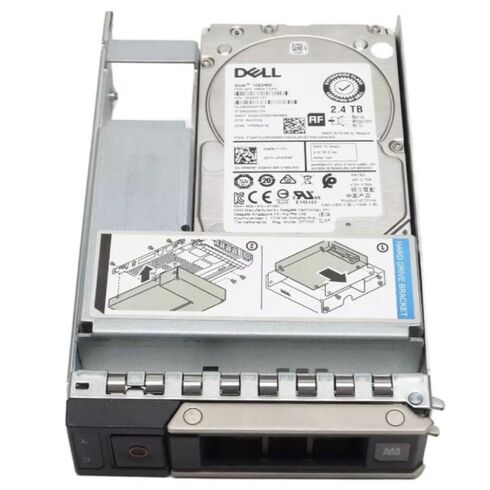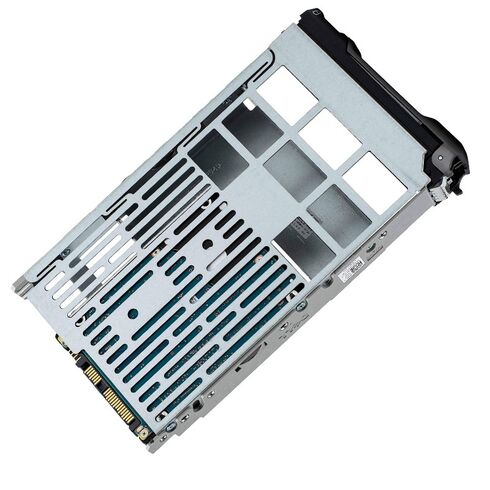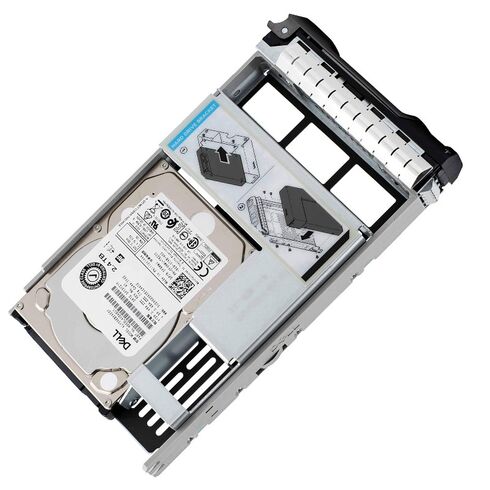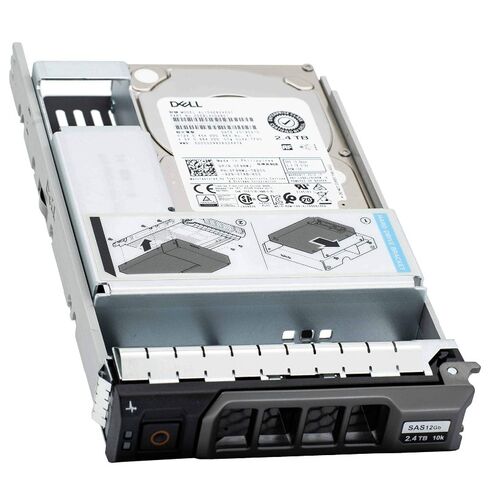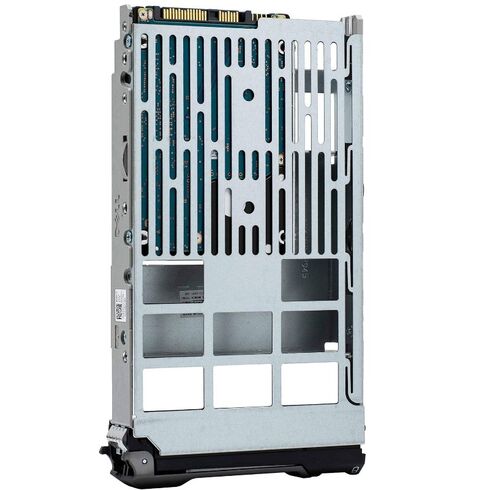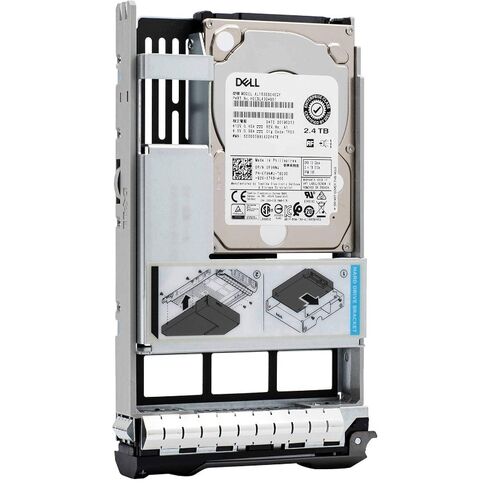400-BBFF Dell 2.4TB 10K RPM SAS-12GBPS 512E 256MB Buffer HDD
- — Free Ground Shipping
- — Min. 6-month Replacement Warranty
- — Genuine/Authentic Products
- — Easy Return and Exchange
- — Different Payment Methods
- — Best Price
- — We Guarantee Price Matching
- — Tax-Exempt Facilities
- — 24/7 Live Chat, Phone Support
- — Visa, MasterCard, Discover, and Amex
- — JCB, Diners Club, UnionPay
- — PayPal, ACH/Bank Transfer (11% Off)
- — Apple Pay, Amazon Pay, Google Pay
- — Buy Now, Pay Later - Affirm, Afterpay
- — GOV/EDU/Institutions PO's Accepted
- — Invoices
- — Deliver Anywhere
- — Express Delivery in the USA and Worldwide
- — Ship to -APO -FPO
- — For USA - Free Ground Shipping
- — Worldwide - from $30
Product Overview
Manufacturer Details
- Brand: Dell
- DELL Part Number: 400-BBFF
- Type: Internal Hard Disk Drive
Specifications
Storage Information
- Capacity: 2.4 Terabytes
- Form Factor: 2.5 Inches (designed for 3.5-inch Hybrid Carrier)
- Connection Interface: SAS 12Gb/s
- Cache Size: 256 Megabytes
- Sector Size: 512e
Performance Metrics
- Rotational Speed: 10,000 RPM
- Average Latency: 2.9 milliseconds
- Sustained Transfer Rate: From 270 to 117 MB/s (measured from outer to inner diameter)
- Multisegment Cache Capacity: 256 Megabytes
- Maximum External Transfer Rate: 1200 Mbps
Advanced Caching Technologies
Performance Enhancements
- I/O Acceleration: Response time optimization is enabled
- NAND Flash Type: EMLC
- NAND Flash Capacity: 16 Gigabytes
- Endurance Management: Intelligent NAND endurance management supported
Connectivity and Expansion
Interface and Compatibility
- Available Interfaces: 1 x SAS 12Gbps
- Compatible Bays: 1 x Hot-swap (2.5 inches in a 3.5-inch Hybrid Carrier)
Buffer: 256MB
The Dell 2.4TB 10K RPM SAS-12GBPS 512E Hard Disk Drive is equipped with a large buffer of 256MB. The buffer, also known as cache, plays a crucial role in enhancing the performance and efficiency of the hard disk drive.
Benefits of a Large Buffer
A large buffer size offers several benefits to users:
Improved Read and Write Speeds
The buffer acts as a temporary storage space for frequently accessed data, allowing the hard disk drive to quickly retrieve and write information. With a larger buffer, the drive can hold more data, resulting in faster read and write speeds. This translates to reduced wait times when accessing files or running applications, leading to improved overall system performance.
Enhanced Multi-Tasking Capability
In scenarios where multiple applications are running simultaneously or there is heavy multitasking, a larger buffer can significantly improve the drive's ability to handle multiple read and write requests efficiently. It helps prevent bottlenecks and ensures smooth operation even under high load conditions.
Optimized Data Transfer
The buffer plays a vital role in optimizing data transfer between the computer's memory and the hard disk drive. It acts as a temporary bridge, allowing for efficient communication between the two components. With a larger buffer, data can be transferred more seamlessly, reducing latency and improving overall data transfer rates.
Reduced Wear and Tear
A larger buffer size can help reduce wear and tear on the hard disk drive by minimizing unnecessary disk access. Frequently accessed data can be stored in the buffer, reducing the need for repeated read operations from the physical disk. This not only improves performance but also prolongs the lifespan of the drive.
Importance of a Large Buffer
The buffer size is an essential factor to consider when choosing a hard disk drive. A larger buffer provides significant advantages in terms of performance, reliability, and user experience.
Improved Productivity
With faster read and write speeds, users can accomplish tasks more quickly, leading to increased productivity. Whether it's loading applications, transferring files, or performing data-intensive operations, a larger buffer ensures that users can work efficiently without experiencing sluggishness or delays.
Smooth Multimedia Playback
A large buffer is particularly beneficial for multimedia enthusiasts who frequently access large media files such as videos or high-resolution images. Streaming and playback become seamless, eliminating buffering issues and ensuring a smooth viewing experience.
Efficient Gaming Performance
Gamers can benefit greatly from a larger buffer size as it reduces load times and enhances in-game performance. With faster data retrieval and reduced latency, gamers can enjoy smoother gameplay, quicker level loading, and improved overall gaming experience.
Reliable Data Storage
A larger buffer helps minimize the risk of data loss or corruption during power outages or sudden system shutdowns. The buffer acts as a temporary storage space where data can be safely stored before being written to the physical disk. This ensures that critical data is preserved and prevents potential data integrity issues.
Interface: SAS-12GBPS
The Dell 2.4TB 10K RPM SAS-12GBPS 512E Hard Disk Drive features a SAS (Serial Attached SCSI) interface with a speed of 12Gbps. The interface is a crucial aspect of the hard disk drive that determines its compatibility, transfer rates, and overall performance.
Benefits of SAS Interface
The SAS interface offers several advantages over other interfaces:
High Data Transfer Speed
With a speed of 12Gbps, the SAS interface provides significantly faster data transfer rates compared to older interfaces such as SATA (Serial ATA). This enables users to transfer large files or perform data-intensive tasks more quickly, resulting in improved productivity and reduced wait times.
Scalability and Expandability
The SAS interface allows for easy scalability and expandability of storage systems. It supports daisy-chaining multiple drives and provides the ability to connect numerous devices in a single chain. This makes it ideal for enterprise environments or setups that require large storage capacities.
Improved Reliability and Redundancy
SAS drives often feature advanced error correction capabilities and built-in redundancy features, such as RAID (Redundant Array of Independent Disks) support. These features help improve the overall reliability of the storage system, ensuring that data remains intact and accessible even in case of drive failures.
Compatibility with Existing Systems
The SAS interface is backward compatible with SATA drives, allowing users to connect SATA drives to SAS controllers. This compatibility provides flexibility and allows for easy integration of existing SATA drives into SAS-based systems without sacrificing performance or functionality.
Importance of SAS Interface
The SAS interface is crucial for users who require high-performance storage solutions with enhanced reliability and scalability.
Enterprise-Level Performance
The high data transfer speed offered by the SAS interface makes it an ideal choice for enterprise-level applications that demand fast and efficient data processing. It ensures that critical business operations, such as database management, virtualization, and server applications, can run smoothly without performance bottlenecks.
Data-Intensive Workloads
Professionals working with data-intensive tasks, such as video editing, 3D modeling, or scientific simulations, can benefit from the fast data transfer rates provided by the SAS interface. It allows for quick access and manipulation of large datasets, improving workflow efficiency and reducing project completion times.
Server and Storage Systems
The SAS interface is widely used in server and storage systems due to its reliability, scalability, and compatibility. It enables efficient management of large amounts of data, facilitating smooth data processing, backup, and retrieval. SAS-based systems are commonly employed in enterprise environments, data centers, and cloud computing setups.
Future-Proofing
Choosing a hard disk drive with a SAS interface ensures compatibility with future advancements in storage technology. As data demands continue to grow, the SAS interface provides a solid foundation for expanding storage capacities and accommodating faster data transfer speeds that may become available in the future.
Capacity: 2.4TB
The Dell 2.4TB 10K RPM SAS-12GBPS 512E Hard Disk Drive offers a generous capacity of 2.4TB. The capacity of a hard disk drive determines the amount of data that can be stored on the drive and is an essential consideration for users with large storage requirements.
Benefits of Large Capacity
A larger capacity hard disk drive offers several advantages:
Ample Storage Space
A drive with a capacity of 2.4TB provides ample storage space for users who work with large files or have extensive media libraries. It allows for storing a vast amount of documents, photos, videos, or other digital assets without the need to constantly manage or delete files to free up space.
Reduced Need for External Storage
With a high-capacity drive, users can eliminate or reduce the reliance on external storage devices such as external hard drives or cloud storage subscriptions. This not only saves costs but also provides convenience by having all data accessible in one location.
Consolidated Data Management
A larger capacity drive enables users to consolidate their data onto a single drive, simplifying data management and organization. Instead of dealing with multiple drives or partitions, users can store all their files and applications on a single drive, making it easier to locate and access data when needed.
Future-Proofing
Choosing a drive with a larger capacity ensures that users have ample room for future data growth. As file sizes continue to increase, driven by higher-resolution media, larger datasets, or advanced software applications, having a 2.4TB capacity allows users to accommodate these growing demands without the need for frequent upgrades or additional drives.
Importance of Large Capacity
The capacity of a hard disk drive is an important consideration for users with extensive storage requirements or those who anticipate future data growth.
Media Professionals and Content Creators
Professionals working in media production, such as photographers, videographers, or graphic designers, often deal with large file sizes. A 2.4TB capacity drive provides ample space to store their high-resolution photos, videos, and other media assets without compromising quality or having to constantly offload data to external storage.
Data-Intensive Applications
Data-intensive applications, such as database servers or virtualization platforms, require significant storage space to accommodate large datasets or multiple virtual machines. A high-capacity drive ensures that these applications can run smoothly without running out of space, preventing potential performance issues or data loss.
Backup and Archiving
For users who prioritize data backup or archiving, a larger capacity drive allows for storing multiple backup copies or archival versions. This ensures that critical data is safeguarded and can be easily recovered in case of accidental deletion, hardware failure, or other data loss events.
Personal Data Storage
Users with extensive personal data, such as multimedia collections, personal documents, or digital libraries, can benefit from a high-capacity drive. It provides a centralized location to store all personal files, simplifying data management and ensuring that important memories or valuable information is securely stored and easily accessible.
Rpm: 10K
The Dell 2.4TB 10K RPM SAS-12GBPS 512E Hard Disk Drive features a rotational speed of 10,000 RPM (rotations per minute). The RPM is a crucial specification that determines the drive's performance, especially in terms of data access speed and overall responsiveness.
Benefits of 10K RPM
A hard disk drive with a rotational speed of 10K RPM offers several advantages:
Faster Data Access
A higher RPM translates to faster data access speeds. The spinning platters inside the hard disk drive rotate more quickly, allowing the read/write heads to reach the desired data location faster. This results in reduced latency and improved overall system responsiveness.
Enhanced Sequential and Random Read/Write Performance
The higher rotational speed enables the drive to deliver improved sequential and random read/write performance. Sequential read/write operations involve accessing large contiguous blocks of data, while random read/write operations involve accessing smaller, scattered data blocks. The 10K RPM drive excels in both scenarios, making it suitable for a wide range of applications and workloads.
Reduced Data Seek Time
The seek time refers to the time it takes for the read/write heads to locate the requested data on the spinning platters. With a higher RPM, the seek time is significantly reduced, allowing for faster data retrieval and improved overall performance. This is particularly beneficial when working with large files or performing data-intensive tasks.
Improved I/O Operations per Second (IOPS)
IOPS is a measure of the number of input/output operations a drive can perform within a second. Higher RPM drives typically exhibit improved IOPS performance, making them suitable for applications that require high transactional throughput or heavy multitasking.
Importance of 10K RPM
The rotational speed of a hard disk drive is an important consideration for users who require fast data access speeds and high-performance storage solutions.
Enterprise Applications
10K RPM drives are commonly used in enterprise environments where fast and reliable storage is essential for critical applications. Database servers, file servers, or virtualization platforms can benefit from the improved performance offered by 10K RPM drives, ensuring smooth operation even under heavy workloads.
Workstations and Power Users
Users who require high-performance storage for demanding tasks, such as video editing, 3D rendering, or scientific simulations, can benefit from the fast data access speeds provided by 10K RPM drives. These drives enable quick access to large files and facilitate efficient data processing, resulting in improved productivity and reduced wait times.
Gaming Performance
Gamers can experience enhanced gaming performance with 10K RPM drives. Faster data access speeds reduce load times, resulting in quicker game launches and level loading. The improved IOPS performance also benefits games that require frequent data retrieval, such as open-world or massively multiplayer online games.
High-Performance Desktops
Users with high-performance desktop systems can take advantage of 10K RPM drives to complement their system's overall capabilities. These drives ensure that storage performance is not a bottleneck, allowing for smooth multitasking, faster application launches, and quicker file transfers.
Form Factor: 2.5 inch
The Dell 2.4TB 10K RPM SAS-12GBPS 512E Hard Disk Drive features a 2.5-inch form factor. The form factor refers to the physical size and shape of the drive, and it plays a crucial role in determining its compatibility with various systems and usage scenarios.
Benefits of 2.5-Inch Form Factor
A hard disk drive with a 2.5-inch form factor offers several advantages:
Compact Size
The smaller size of the 2.5-inch form factor makes it ideal for compact devices such as laptops, ultrabooks, or small form factor desktops. These drives take up less physical space and allow for more efficient utilization of the available internal storage compartments in such devices.
Increased Portability
The compact size of 2.5-inch drives enhances portability, making them easier to carry and transport compared to larger form factors. This is particularly beneficial for users who frequently travel or need to transfer data between different locations.
Compatibility with Mobile Devices
2.5-inch drives are commonly used in mobile devices, including laptops, notebooks, and portable storage solutions. By choosing a drive with a 2.5-inch form factor, users can ensure compatibility with their mobile devices and seamlessly integrate the drive into their existing systems.
Lower Power Consumption
2.5-inch drives generally consume less power compared to larger form factors. This is advantageous in scenarios where power efficiency is a priority, such as in battery-powered devices like laptops or portable storage solutions. Lower power consumption results in extended battery life and reduced heat generation.
Importance of 2.5-Inch Form Factor
The form factor of a hard disk drive is an important consideration depending on the intended usage and compatibility requirements.
Laptop and Notebook Upgrades
Users looking to upgrade the storage capacity of their laptops or notebooks can benefit from a 2.5-inch drive. These drives are commonly compatible with standard laptop storage bays, allowing for easy installation without the need for additional adapters or modifications.
Portable Storage Solutions
For users who require portable storage solutions, such as external hard drives or portable backup devices, a 2.5-inch drive provides a compact and lightweight option. These drives can be easily carried in a bag or pocket and are suitable for users who need to access their data on the go.
Small Form Factor Desktops
Small form factor desktop systems, such as mini PCs or compact workstations, often have limited internal space for storage devices. By opting for a 2.5-inch drive, users can take advantage of the smaller form factor to accommodate their storage needs without compromising on system size or performance.
Enterprise Storage Solutions
In enterprise environments, 2.5-inch drives are commonly used in storage arrays or servers that require high-density storage systems. The smaller form factor allows for increased storage capacity within a limited physical footprint, making it an efficient choice for data centers or server rooms.

